Interview with Makoto Shinkai on his feature film ‘Suzume’
How does one grieve a place? The popular director offers some answers in this deeply moving animated film.
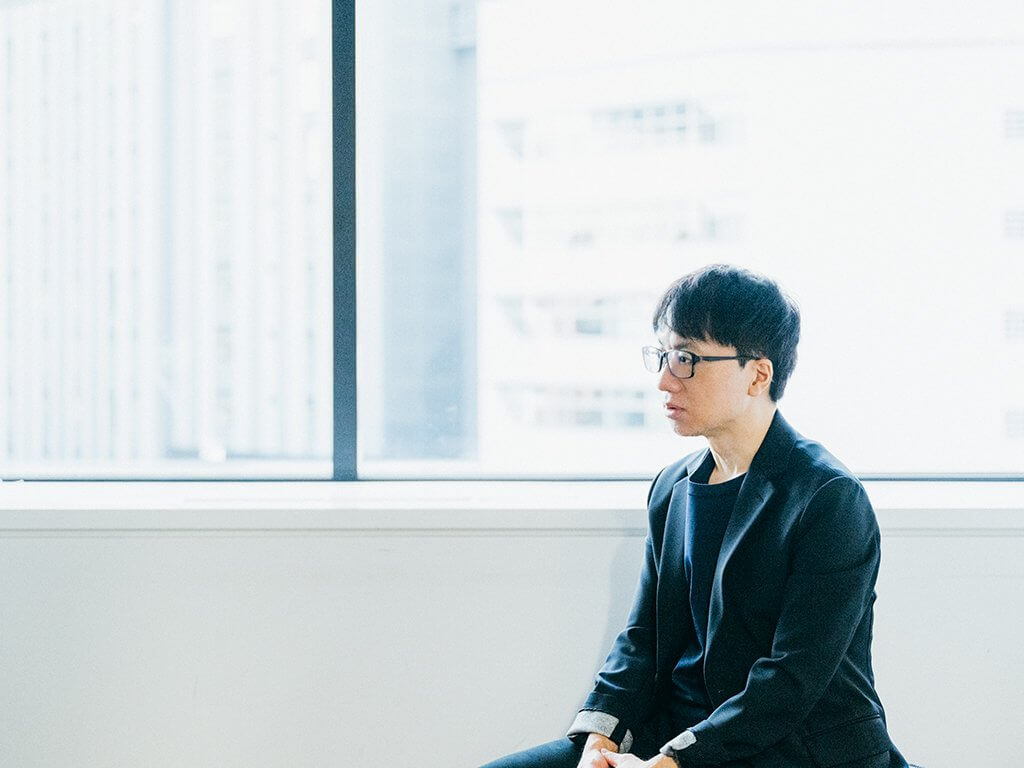
Upon its release, Suzume claimed the top spot at the Japanese box office.
Makoto Shinkai began writing the screenplay as the COVID-19 crisis began, incorporating his diverse emotions into it. He is interviewed here by renowned Japanese literary critic Masaki Enomoto. This article was published in the January 2023 issue of Pen.
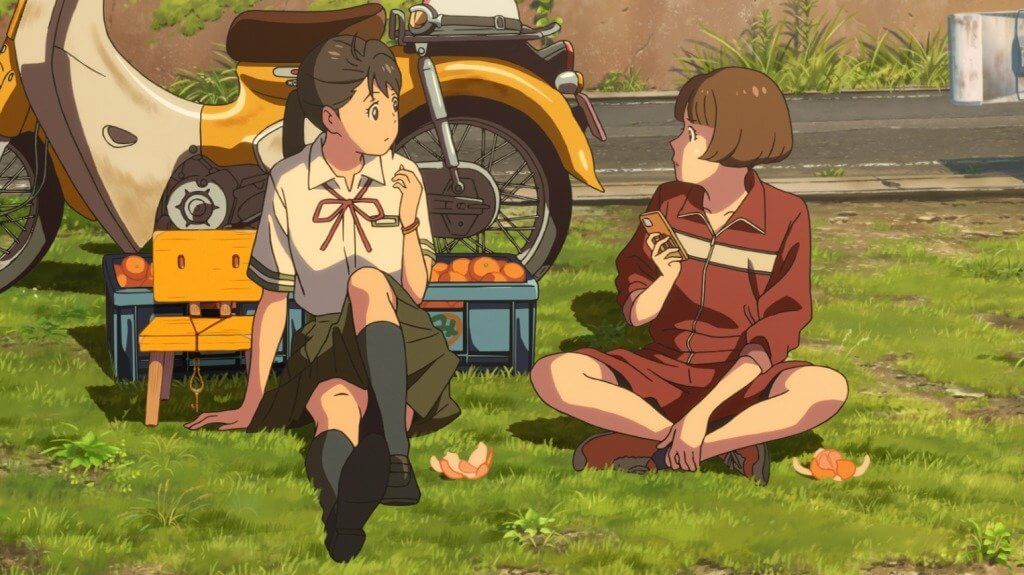
A girl of the same age met during the journey.
Masaki Enomoto: In December 2021, during the press conference announcing the production of your film, the title (‘Suzume’, which means ‘sparrow’ in Japanese) struck me as somewhat antiquated. Sparrows have long been associated with the common people and appear in numerous tales and folklore. The heroine’s last name, Iwato, as you’ve noted, even comes from the legend of Amano-Iwato, the cave in which the Japanese sun goddess Amaterasu hid, according to Japanese mythology.
Makoto Shinkai: Indeed, I chose the title to evoke the atmosphere of folk tales and legends. A title that recalls ancient times, one that has fallen out of fashion, seemed more appropriate for this film. Suzume resonates with significant events that actually occurred, but I believe it’s one of the roles of storytelling to draw inspiration from reality and present it in a fictional form. When unimaginable events take place, people often encapsulate them in tales and legends to better understand them. By narrating these events, they make them more comprehensible and use them to grasp what happened. This is a behavior frequently observed in humanity. In this film, we also tried to convey, in the form of a narrative, what had occurred in reality.
Masaki Enomoto: In your previous works, the story unfolded along an axis between Tokyo and the countryside. In ‘Suzume’, the action takes place in every location visited by the heroine as she travels across Japan. It’s a departure from your usual work; is there a reason behind this change?
Makoto Shinkai: If I wanted to create a road movie in which the heroine, Suzume, travels throughout Japan, it’s primarily because I wanted to explore the grief associated with a place. When a person passes away, there are funerals to mark their departure. However, when people leave cities or regions, and entire places are lost, there’s no ceremony of that kind. When I contemplated making a film about mourning a place, to evoke such locations, it became necessary to travel from region to region. Consequently, it inevitably became a travel narrative set against the backdrop of the entire Japanese territory. My initial intention was not to create a travel narrative but a story about mourning a place, and from there, the film took on the form of a road movie.
Masaki Enomoto: The constant change of locations gives the film an action-packed feel. This work addresses serious issues, but at the same time, the incidents that occur throughout the journey add a dose of humor to the production. The story can be enjoyed purely for entertainment as well.
Makoto Shinkai: From the outset, I wanted the film to be entertaining, and as you mentioned, the journey itself has that effect. It’s akin to RPG video games, where merely moving your character through the environment is enjoyable (laughs). Humans are creatures capable of appreciating a process without fixating on its goal. The journey itself is enjoyable, and the accompanying dialogues are equally so.
Masaki Enomoto: Suzume forms connections with locals in each place she visits. Each interaction provides insight into the regional culture, dialect, cuisine, and customs. Suzume herself experiences this, notably through the songs from the Showa era, which are unfamiliar to her.
Makoto Shinkai: I started with the desire to create a story about mourning a place, and as the story took shape, I contemplated how Suzume would communicate with others and the cultural experiences she might have. My initial image was that of Kiki’s Delivery Service from Hayao Miyazaki. During the press conference to announce the film, the behind-the-scenes video revealed that my film had been influenced by Kiki’s Delivery Service. This coming-of-age story of a young girl hasn’t aged a day. While learning witchcraft, Kiki encounters various characters, including Ursula and Osono. Many characters stand out, including women who seem to embody possible futures for Kiki. Although the setting, aesthetics, and substance of Kiki’s Delivery Service are entirely different, I wanted Suzume to meet different women. I wanted the people encountered in each location to work, and this led to a series of previously unrepresented characters, such as the girl helping out at the family guest house or the bar owner. These women play a catalytic role in exposing Suzume to unfamiliar cultures.
Masaki Enomoto: Suzume receives different things from these women. She receives from them and also gives to them. Suzume and the women she meets on her journey are connected by the act of giving. Both Chika and Rumi spend only a brief time interacting with Suzume but hold her in particular affection. These women may not know the specific details, but they somehow understand that Suzume is undertaking an important task.
Makoto Shinkai: Again, I wanted to reference legends and create a story about giving. The hat that Rumi gives to Suzume doesn’t necessarily serve any particular function (laughs), but I wanted her to offer something, so I imagined the scene where Rumi places her hat on Suzume’s head. Chika’s words, ‘You seem to be in charge of an important task’, or Sōta’s words, ‘It’s better if people don’t realize you’re doing important work’, are advice given by other characters to guide Suzume. These ideas came to me while writing the script. I think of the fundamental sections of the film’s plot as steps in a staircase. How is Suzume’s journey connected to Sōta, and where will she ultimately arrive? What must she do? It’s from these kinds of details that I construct the plot and start writing the script. However, an exchange between Chika and Suzume, as described earlier, came to me spontaneously when imagining the relationship between the two characters.
A film aimed at audiences living in the same environment
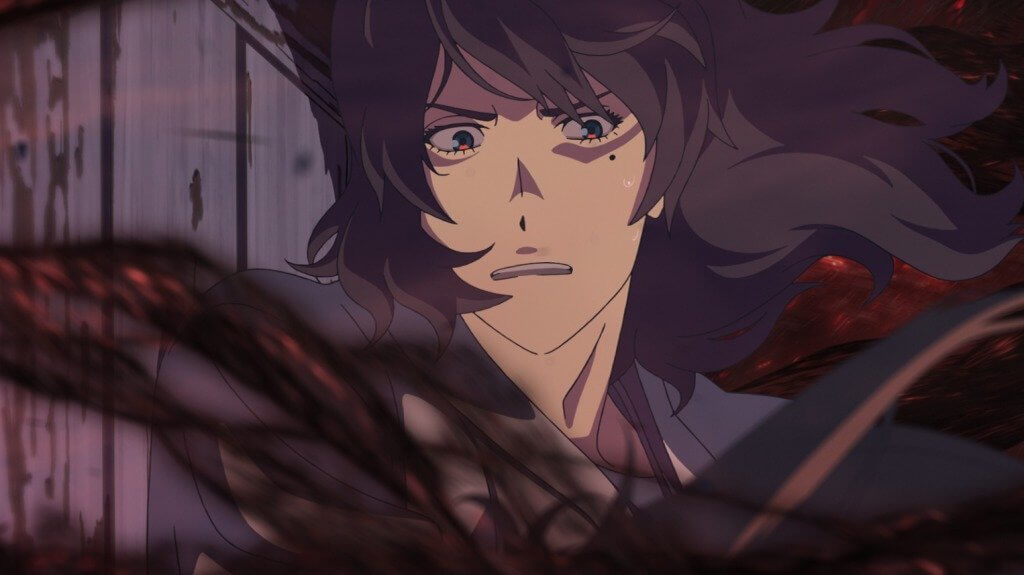
Sōta, the master of closing doors, journeys alongside Suzume.
Masaki Enomoto: When Suzume and her allies close doors, it’s not just about avoiding disasters and returning the land to its original owner, Ubusuna. There’s a deeper meaning behind it for Japan today. Japan’s modernisation has essentially been a series of door openings. This has led to a certain prosperity, but today, we are starting to see the end of this optimistic period. Declining birth rates, population decreases, and villages abandoned by the younger generation are among the current issues in Japan, and its future decline in power is predicted. Based on your film’s narrative, in many parts of Japan, people’s memories will begin to fade, and the possibility of hidden doors appearing will increase. We shouldn’t bequeath to future generations all these accumulating problems, but we should take responsibility, close the doors, and solve the issues. It seemed to me that this was part of the hidden meaning of the various issues addressed in the film.
Makoto Shinkai: Closing doors in the film means returning places borrowed by humans from local deities. ‘I’m returning it to you.’ Uttering this incantation triggers a series of actions to close the door. I found this moment attractive as it constitutes the action scenes of the film. Of course, at that time, I also considered that Suzume and her companions had to continue their journey because I was making a road movie. But it’s true that, on the other hand, my feelings about the state of our society are also lightly reflected in it. I wrote the screenplay at the beginning of the COVID-19 crisis, and it was a turbulent period in our society, especially regarding the holding of the Tokyo Olympics. Ultimately, the Olympics were held, and I thought that by counting the new national stadium and all the developments in its vicinity, we had opened a new door without even knowing how to close others. Hosting the Olympics without lockdowns and opening doors without considering closing others seemed like irresponsible acts to me. My hostility toward this situation and my irritation were some of the reasons why I created a narrative of closure rather than opening.
Masaki Enomoto: Now let’s discuss two fundamental elements that are pivotal to the work: the worm and the sacred stone ‘kaname-ishi.’ In ‘Weathering with You,’ there’s a scene at the Kisho Shrine for which Nizō Yamamoto, the art decorator, drew a map representing ‘The Great Earthquake of Japan.’ In the scenario for this scene, there’s mention of ‘an ancient painting of the dragon-snake Ryuja encircling the Japanese archipelago’ and also of ‘above the Joban region, a sword that becomes kaname-ishi.’ The connection between the dragon, symbolized here by the worm, and ‘kaname-ishi’ might be traced back to ‘Weathering with You.’
Makoto Shinkai: Now that you mention it, that’s indeed the impression it gives, as in the scene at the Kisho Shrine, the painting that we glimpse is indeed the old representation of the dragon Ryuja encircling Japan. In Suzume, there’s a scene in Sōta’s apartment where you can see books depicting the old painting and the kaname-ishi, but it’s not so much that I planted clues in Weathering with You as it resulted from a fortuitous connection. An atmosphere like that in Weathering with You with water vapor and updrafts is invisible to the human eye. The water vapor currents within the atmosphere are only visible to the time priestesses. The phenomena of water circulation within the atmosphere are considered by humans to be living beings in the sky, akin to fish. In Weathering with You, I truly expressed my worldview. In Suzume too, there’s a theory that earthquakes occur based on the movements of tectonic plates, and the tremendous energy accumulated in the ground gives rise to the phenomenon of the worms that Suzume and Sota observe. Since I made two films when I was influenced by this way of thinking, I changed the dragon surrounding the Japanese archipelago in Weathering with You and envisioned it as a worm extending in the depths of the archipelago.
Masaki Enomoto: If we look at your recent works from a macroscopic perspective, it seems like your viewpoint on the environment, folklore, and Japanese history has solidified, and we understand how this country emerged and how its inhabitants live.
Makoto Shinkai: I am aware of that. In this film, there’s this phenomenon of the worm that consumes soil and creates soil. All of this is related to the land, isn’t it? Soil is an organic material formed from sediments derived from corpses, so we are standing on a pile of sediments formed by innumerable corpses of living beings, and this is also part of our environment. The soil of this region is one of its natural characteristics, and we walk on this land, feel it under our feet, eat what grows on it, and contemplate the surrounding landscapes. In a primitive sense, isn’t the origin of peoples found in the soil? We who live in the same environment share something like a common mindset, and that’s what I wanted to express in a film. This desire has intensified, particularly since Your Name. I don’t have much connection to Shinto or consider myself a very spiritual person. But during New Year’s, I try to do Hatsumōde (the first shrine visit of the year), and when I visit a region in Japan that I don’t know, I can sense the presence of the deities of that place. I wonder if everyone doesn’t have this simple sensitivity.
Transmitting the reality of the 2011 catastrophe to a decade-old audience
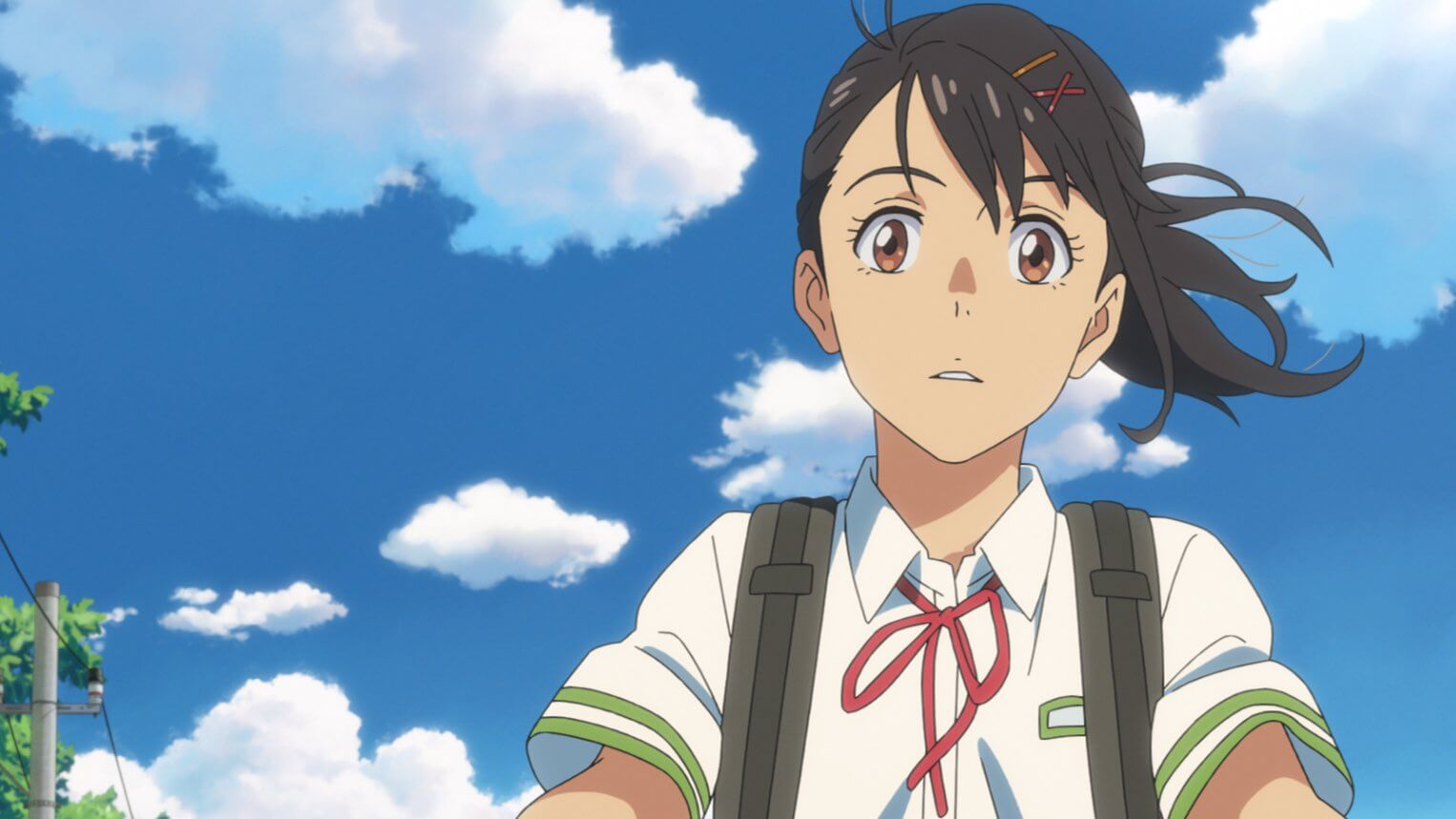
A 17-year-old high school student, Suzume, lives alone with her aunt, Tamaki.
Masaki Enomoto: From ‘Your Name’ to ‘Suzume,’ there’s a series of works in which you depict natural disasters. One could even consider it a trilogy. In ‘Your Name’ and ‘Weathering with You,’ it’s not earthquakes but other natural disasters. In ‘Suzume,’ it’s the first time you directly depict an earthquake. Is it because eleven years have passed since the Great East Japan Earthquake, and now you’re able to address it?
Makoto Shinkai: There are several reasons, but yes, that’s part of it. When I examine my nature and past experiences, I wasn’t initially an author capable of producing a work like Suzume. At the beginning of my career, I left large-scale narratives to others, thinking I had other things to do, and I started making animated films. Back then, I built my stories from everyday emotions, like my state of mind when taking the train or entering a convenience store. But the expression of these everyday-based feelings blended with the profound shock I felt in 2011 and resulted in Your Name. With Your Name, I met an audience of 10 million viewers for the first time. In the wake of the impact of Your Name, I felt I needed to provide a response, so I produced Weathering with You. Once again, in response to all the feedback I received, both positive and negative, I created Suzume. I believe Suzume is a film I was able to unexpectedly create thanks to the responses of the viewers who watched Your Name and Weathering with You and with whom I was able to interact.
Masaki Enomoto: During the press conference announcing the completion of the film, you mentioned that the reason you brought up the Great East Japan Earthquake was your impatience with the fact that people’s memories of the disaster as a common language are fading from their minds. In each of your works, there’s a power that captivates the viewer and transcends eras. Beyond today’s viewers, this power could touch future viewers. Similar to the role of the Miyamizu family in ‘Your Name,’ whose purpose is to pass down memories from generation to generation to escape disasters, what do you think of the possibility of a work that archives memory to transmit it to the future?
Makoto Shinkai: I don’t really think about creating a film that will last five years, ten years, or more. I’m already very happy that viewers of my era are watching it today. However, I did have a feeling that if I didn’t do it now, it would be too late. In reality, I had this thought yesterday. On Friday, the day the film was released in theaters, Your Name was broadcast on TV, and because I was working and not at home, I couldn’t watch it. But my twelve-year-old daughter sent me a message saying, ‘I watched it!’ My wife also sent me a photo of my daughter in tears. Since she was six, she has watched Your Name countless times, but now, for the first time, she understood its meaning. She told me, ‘This film is really good!’ (laughs) But my twelve-year-old daughter probably doesn’t associate this film with the Great East Japan Earthquake. She surely can’t imagine that I used the metaphor of a comet that only strikes the earth once every thousand years to represent the earthquake. It’s an event that my daughter’s generation can’t connect to the earthquake. In fact, many of my viewers are around ten years old, and I think they feel the same way. In a year, in two years, the distance from the earthquake will only increase. On the other hand, like Suzume, there are also people for whom the memory of the earthquake is still very vivid. Suzume and my daughter don’t have many years between them. If, through an entertainment story like Suzume, viewers around ten years old can maintain a connection to the world of eleven years ago, it’s probably the only meaningful work we can create, I believe.
Masaki Enomoto: One common thread in the films of this trilogy is that children participate in saving a world in crisis by correcting the deformities of that world. What feelings have you entrusted to the children in this trilogy?
Makoto Shinkai: Children have the most vivid and radiant experience of the world. More than adults, they strongly feel things, whether it’s sorrow or joy, colors or scents. In this sense, children can be considered the leading actors of the world. It’s perhaps with this feeling that I made these films.
A new type of characters brings a new type of connection
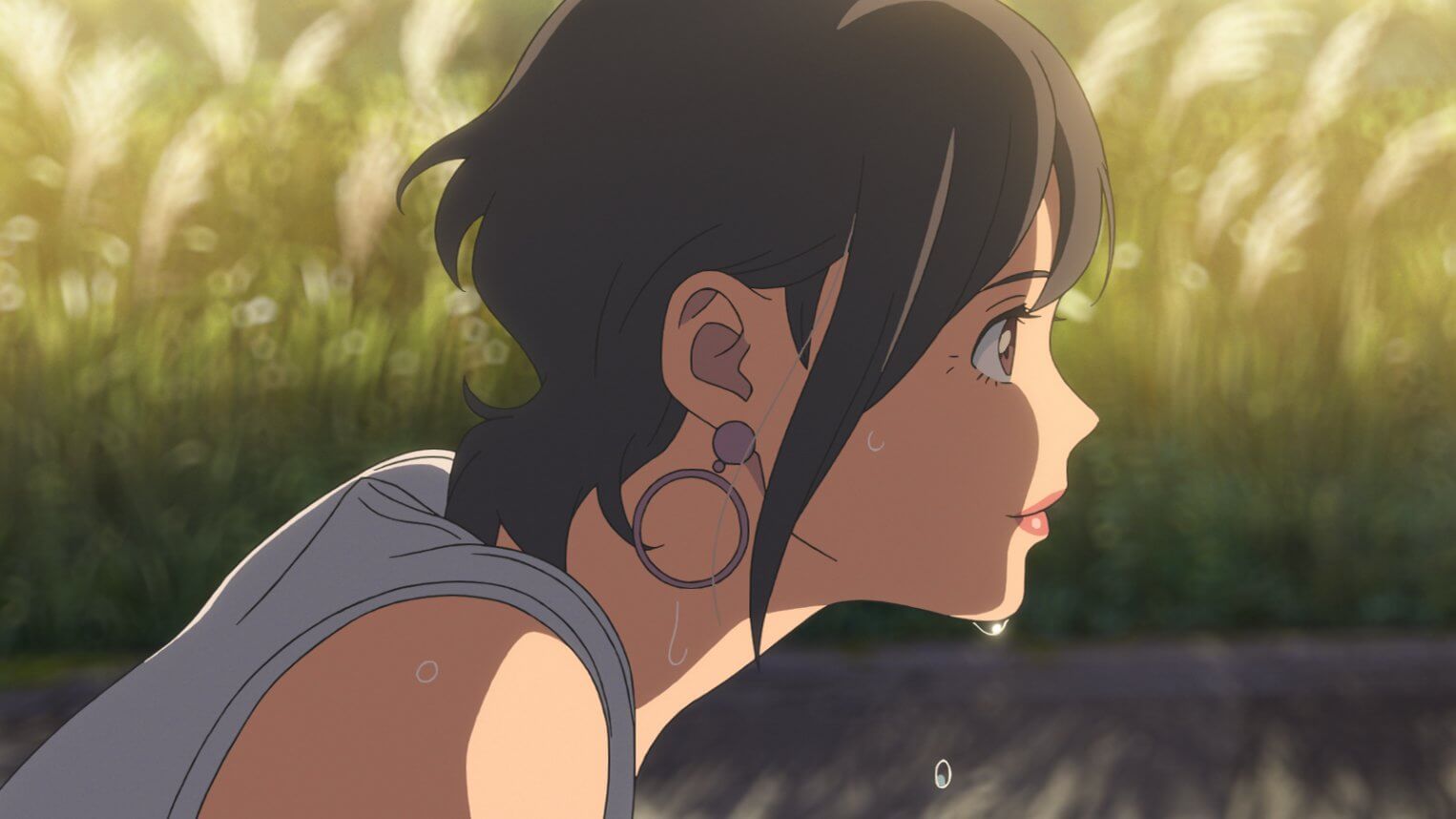
Tamaki, Suzume's aunt. She raised her since she was very young.
Masaki Enomoto: You don’t achieve an entertaining film solely with serious societal themes. It’s important in a work that these themes and entertainment coexist. How did you think about these two elements and bring them together?
Makoto Shinkai: When I decided to address the Great East Japan Earthquake, I thought that if, conversely, I didn’t make an entertaining film, it wouldn’t make sense. I wanted to create a film where, from one scene to the next, the viewer could laugh, and that the entire film would be entertaining. Even with a real tragedy as the backdrop, not being able to address it in an entertaining way, on the pretext that it would be inappropriate, would be the real tragedy, in my opinion. It’s a work of fiction with a depiction of real events, and my goal was to represent the exchange of genuine feelings. In the final scene, Suzume speaks certain words to another character, and these words, in themselves, are not a lie. These words aren’t transmitted through a phenomenon or supernatural powers. They are just truthful words.
Masaki Enomoto: The exchange that happens in this scene is something we engage in daily life, isn’t it?
Makoto Shinkai: In our everyday lives, just like in that scene, we sometimes want to say, ‘It’s going to be okay,’ ‘You’re going to grow up well,’ or ‘What we just went through was tough, but in a few years, we’ll be able to laugh again.’I think that I have depicted the same thing over and over again in my works. In 5 Centimeters Per Second, I had Akari say, ‘Takaki, I’m sure everything will be okay,’ in Weathering with You, I wrote the words ‘everything will be fine for us.’ These words were not only a message to the characters and the audience, but also words I was giving to myself. I think that Suzume’s words will simply touch the viewers, and if they understand this message as not being a lie, then I would be very happy.
Masaki Enomoto: This work, as well as ‘Weathering with You,’ is challenging to put into words. This year marks twenty years since the release of your first short film, ‘The Voices of a Distant Star.’ In your previous works, you depicted situations of dysfunctional communication, where characters didn’t understand each other. In your more recent films, it seems like there’s a change and more possibilities for exchange.
Makoto Shinkai: In my early works, I dealt with communication problems a lot. There were such issues in my surroundings, and I had few opportunities to interact with my audience. So I didn’t depict what I didn’t know. I continued to create, and over time, I was able to exchange ideas and feelings with my viewers, but it may have taken twenty years to get there.
Masaki Enomoto: Up to this point in your works, we had never seen such supporting characters with whom Suzume would form new connections. Tamaki, Suzume’s aunt, seems particularly important. The twelve years Suzume has lived have also been experienced by Tamaki, and, as in all families, in order to live with her niece, Tamaki made sacrifices. There’s a scene where Tamaki releases all the accumulated and repressed pressure. Strangely, during her journey with her niece, Tamaki takes stock of her past life.
Makoto Shinkai: Tamaki appears in few scenes, but I believe she leaves a deep impression on the viewer. From the beginning, I was aware that Tamaki would be a focal point of the narrative. The entire team was concerned about her fate, and several times during production, she felt like a real person to us. When Yōjirō Noda composed the soundtrack, one of the tracks was named ‘Tamaki.’ It’s a song in which Tamaki shares her deep feelings, and we ultimately didn’t use it in the film. But the fact that Yōjirō went to the trouble of finalizing that piece is because Tamaki touched him. I think that if Eri Fukatsu agreed to voice Tamaki, it’s because she had this special role. That’s why, during dubbing, Tamaki’s character gained depth, and I learned a lot from Eri Fukatsu myself. I’m very grateful to her for immersing herself so deeply in the character.
Masaki Enomoto: Chika, Rumi, her twins, and Tomoya Serizawa are types of characters we hadn’t seen in your previous works. It seems like in this film, you experimented and explored new connections with them.
Makoto Shinkai: It’s a serious and meaningful journey, so I thought it should be interspersed with encounters that would make it more enjoyable, and thus I created these characters. There’s a difference between characters who advance the plot and those who only express themselves, and that’s why I wanted to include new encounters.
Masaki Enomoto: Did you emphasize letting the characters evolve freely so that their connections with Suzume would feel more natural, beyond their narrative function?
Makoto Shinkai: Yes, of course. When I started thinking about the plot, it felt like I was assembling a complex puzzle where I had to arrange all the dialogues and characters based on their roles. In doing so, everything can become quite mechanical, so you need to find a way to make things more lively. That’s when, for the first time, certain words came to me. Then comes the stage where the protagonists’ personalities take shape, during the storyboard phase. I create a video storyboard, and it’s up to me to interpret all the dialogues; for example, I’ll take on the voice of Rumi to rearrange everything. At that moment, I notice certain things for the first time. For example, in the scene where Serizawa drives Suzume’s team in his car, he plays them music. This element wasn’t in the script. It was during the creation of the video storyboard that I first felt that, at that moment, he should play some music. I thought that for the viewers following Suzume and her tense situation right up to the climax, it would be difficult to experience a film with so much pressure. And then, when I thought about Serizawa’s character, I figured that a chatty and carefree character like him wouldn’t stay silent throughout the journey. I thought he’d at least hum a song, so I thought about what he could sing… From there, I came up with the idea that he would play a nostalgic song.
Reclaiming lost ‘goodbyes’
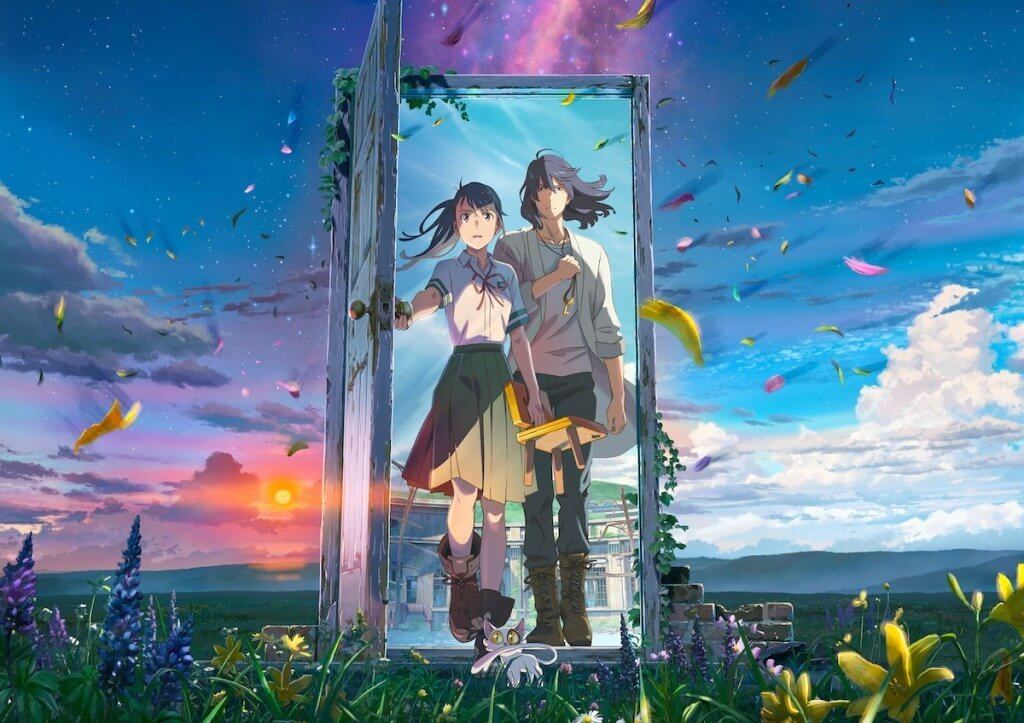
Masaki Enomoto: There’s one scene in ‘Suzume’ in particular that is unforgettable. When the city is completely transformed, for a moment, we return to the city as it was before, and we hear the voices of its inhabitants exchanging ‘goodbyes’ (in Japanese, this expression implies that one leaves a place to return later, literally ‘I’m going to come back’). It deeply moved me. ‘Goodbye’ is an expression that has a special meaning in ‘Suzume.’ It’s something everyone says in the morning when leaving home, a daily expression, and that’s why these words are irreplaceable. This everyday habit of exchanging ‘goodbyes’ is deteriorating. It seems to me that this film has the power to restore this daily ritual.
Makoto Shinkai: In this scene, ‘goodbyes,’ depending on how you interpret them, can be perceived as cruel because there will be no return. The fact that, for a moment, we revisit the bygone days of this city and hear the voices of various people, just like the scene mentioned earlier where Serizawa plays retro music, was not in the script. I may have subconsciously avoided drawing this scene because, although the city is imaginary, the events taking place there are drawn from reality, and it could be morally questionable to feature them. During the viewing of the video storyboard, with that scene not yet included, the reactions of my team were mixed, and I also did not feel right. After I went home and thought about it, I realized that it was only by revisiting the ruins of every place that Suzume’s group passed through and remembering their former glory that the door could close. Therefore, this moment could only be somber. By adding this final scene, I was able to come to terms with the fact that this film would clearly address the Great East Japan Earthquake.
Suzume (2022), an animated film directed by Makoto Shinkai and not currently available for streaming.
© 2022 ‘Suzume’ Film Partners
TRENDING
-
Hiroshi Nagai's Sun-Drenched Pop Paintings, an Ode to California
Through his colourful pieces, the painter transports viewers to the west coast of America as it was in the 1950s.

-
The Tattoos that Marked the Criminals of the Edo Period
Traditional tattoos were strong signifiers; murderers had head tattoos, while theft might result in an arm tattoo.

-
David Bowie Dressed by Kansai Yamamoto
The English singer was strongly influenced by 'kabuki' theatre and charged the Japanese designer with creating his costumes in the 1970s.

-
‘Seeing People My Age or Younger Succeed Makes Me Uneasy’
In ‘A Non-Conformist’s Guide to Surviving Society’, author Satoshi Ogawa shares his strategies for navigating everyday life.

-
Yoichi Ochiai, the artist behind the media art pavilion at World Expo 2025 Osaka
A recipient of the Pen Creator Awards 2025, he reflects in this interview on an immersive work translating ‘Digital Nature’ into art.





